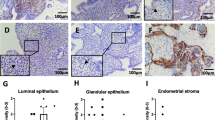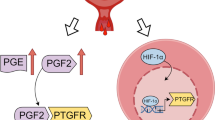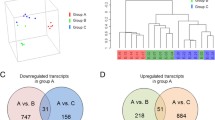Abstract
The aim of this study was to investigate tissue factor (TF) and its inhibitors TFPI and TFPI2 in secretory endometrium of fertile women and in women with unexplained infertility in relation to endometrial receptivity. In addition, common variation in the regulatory area of TF and TFPI genes was studied. Immunostaining of TF and TFPI, together with the appearance of pinopodes, revealed similar expression pattern in fertile endometrium throughout the secretory phase, being highest at the time of implantation. When compared protein expression levels at the time of implantation, infertile women demonstrated significantly higher TFPI expression in luminal epithelium. Furthermore, polymorphism TF-603 A/G was associated with the endometrial protein level in infertile women, being highest in women with GG genotype, and variation TFPI-287 T/C was associated with unexplained infertility, where infertile women presented more frequently T allele than fertile women. Contrary to TF and TFPI, TFPI2 showed different mRNA and protein expression patterns in fertile endometrium, and no differences between fertile and infertile women were detected. We conclude that the TF pathway is involved in normal endometrial maturation, where TF and TFPI seem to have important roles at the time of embryo implantation. Higher TFPI expression level during the time of embryo implantation and TFPI-287 T allele could be risk factors for unexplained infertility. No distinct involvement of TFPI2 in the regulation of endometrial receptivity and unexplained infertility was found.
Similar content being viewed by others
References
Harper MJ. The implantation window. Baillieres Clin Obstet Gynaecol. 1992;6(2):351–371.
Achache H, Revel A. Endometrial receptivity markers, the journey to successful embryo implantation. Hum Reprod Update. 2006;12(6):731–746.
Altmäe S, Haller K, Peters M, et al. Allelic estrogen receptor 1 (ESR1) gene variants predict the outcome of ovarian stimulation in in vitro fertilization. Mol Hum Reprod. 2007;13(8):521–526.
Aghajanova L, Simón C, Horcajadas JA. Are favorite molecules of endometrial receptivity still in favor?. Expert Rev Obstetr Gynecol. 2008;3(4):487–501.
Lockwood CJ, Krikun G, Papp C, et al. The role of progestationally regulated stromal cell tissue factor and type-1 plasminogen activator inhibitor (PAI-1) in endometrial hemostasis and menstruation. Ann N Y Acad Sci. 1994;734:57–79.
Lockwood CJ, Krikun G, Schatz F. The decidua regulates hemostasis in human endometrium. Semin Reprod Endocrinol. 1999;17(1):45–51.
Price GC, Thompson SA, Kam PC. Tissue factor and tissue factor pathway inhibitor. Anaesthesia. 2004;59(5):483–492.
Krikun G, Lockwood CJ, Paidas MJ. Tissue factor and the endometrium: from physiology to pathology. Thromb Res. 2009;124(4):393–396.
Nemerson Y. Tissue factor and hemostasis. Blood. 1988;71(1):1–8.
Chen VM, Ahamed J, Versteeg HH, Berndt MC, Ruf W, Hogg PJ. Evidence for activation of tissue factor by an allosteric disulfide bond. Biochemistry. 2006;45(39):12020–12028.
Chen VM, Hogg PJ. Allosteric disulfide bonds in thrombosis and thrombolysis. J Thromb Haemost. 2006;4(12):2533–2541.
Wolberg AS, Monroe DM, Roberts HR, Hoffman MR. Tissue factor de-encryption: ionophore treatment induces changes in tissue factor activity by phosphatidylserine-dependent and -independent mechanisms. Blood Coagul Fibrinolysis. 1999;10(4):201–210.
Toomey JR, Kratzer KE, Lasky NM, Stanton JJ, Broze GJ Jr. Targeted disruption of the murine tissue factor gene results in embryonic lethality. Blood. 1996;88(5):1583–1587.
Parry GC, Erlich JH, Carmeliet P, Luther T, Mackman N. Low levels of tissue factor are compatible with development and hemostasis in mice. J Clin Invest. 1998;101(3):560–569.
Pawlinski R, Fernandes A, Kehrle B, et al. Tissue factor deficiency causes cardiac fibrosis and left ventricular dysfunction. Proc Natl Acad Sci U S A. 2002;99(24):15333–15338.
McMaster MT, Dey SK, Andrews GK. Association of monocytes and neutrophils with early events of blastocyst implantation in mice. J Reprod Fertil. 1993;99(2):561–569.
Huang ZF, Broze G Jr. Consequences of tissue factor pathway inhibitor gene-disruption in mice. Thromb Haemost. 1997;78(1):699–704.
Pedersen B, Holscher T, Sato Y, Pawlinski R, Mackman N. A balance between tissue factor and tissue factor pathway inhibitor is required for embryonic development and hemostasis in adult mice. Blood. 2005;105(7):2777–2782.
Udagawa K, Yasumitsu H, Esaki M, et al. Subcellular localization of PP5/TFPI-2 in human placenta: a possible role of PP5/TFPI-2 as an anti-coagulant on the surface of syncytiotrophoblasts. Placenta. 2002;23(2–3):145–153.
Almasy L, Soria JM, Souto JC, et al. A locus on chromosome 2 influences levels of tissue factor pathway inhibitor: results from the GAIT study. Arterioscler Thromb Vasc Biol. 2005;25(7):1489–1492.
Arnaud E, Barbalat V, Nicaud V, et al. Polymorphisms in the 5’ regulatory region of the tissue factor gene and the risk of myocardial infarction and venous thromboembolism: the ECTIM and PATHROS studies. Etude Cas-Temoins de l’Infarctus du Myocarde. Paris Thrombosis case-control Study. Arterioscler Thromb Vasc Biol. 2000;20(3):892–898.
Moatti D, Seknadji P, Galand C, et al. Polymorphisms of the tissue factor pathway inhibitor (TFPI) gene in patients with acute coronary syndromes and in healthy subjects: impact of the V264M substitution on plasma levels of TFPI. Arterioscler Thromb Vasc Biol. 1999;19(4):862–869.
Ott I, Koch W, von Beckerath N, et al. Tissue factor promotor polymorphism -603 A/G is associated with myocardial infarction. Atherosclerosis. 2004;177(1):189–191.
Reny JL, Laurendeau I, Fontana P, et al. The TF-603A/G gene promoter polymorphism and circulating monocyte tissue factor gene expression in healthy volunteers. Thromb Haemost. 2004;91(2):248–254.
Terry CM, Kling SJ, Cheang KI, Hoidal JR, Rodgers GM. Polymorphisms in the 5′-UTR of the tissue factor gene are associated with altered expression in human endothelial cells. J Thromb Haemost. 2004;2(8):1351–1358.
Skretting G, Stavik B, Landvik NE, et al. Functional characterization of polymorphisms in the human TFPI gene. Biochem Biophys Res Commun. 2010;397(1):106–111.
WHO. Laboratory Manual for the Examination of Human Semen and Sperm-Cervical Mucus Interaction. 4th ed. Cambridge: Cambridge University Press; 1999.
Aghajanova L, Altmäe S, Bjuresten K, Hovatta O, Landgren BM, Stavreus-Evers A. Disturbances in the LIF pathway in the endometrium among women with unexplained infertility. Fertil Steril. 2009;91(6):2602–2610.
Noyes RW, Hertig AT, Rock J. Dating the endometrial biopsy. Am J Obstet Gynecol. 1975;122(2):262–263.
Altmäe S, Martinez-Conejero JA, Salumets A, Simon C, Horcajadas JA, Stavreus-Evers A. Endometrial gene expression analysis at the time of embryo implantation in women with unexplained infertility. Mol Hum Reprod. 2010;16(3):178–187.
Crawley J, Lupu F, Westmuckett AD, Severs NJ, Kakkar VV, Lupu C. Expression, localization, and activity of tissue factor pathway inhibitor in normal and atherosclerotic human vessels. Arterioscler Thromb Vasc Biol. 2000;20(5):1362–1373.
Edstrom CS, Calhoun DA, Christensen RD. Expression of tissue factor pathway inhibitor in human fetal and placental tissues. Early Hum Dev. 2000;59(2):77–84.
Runic R, Schatz F, Krey L, et al. Alterations in endometrial stromal cell tissue factor protein and messenger ribonucleic acid expression in patients experiencing abnormal uterine bleeding while using Norplant-2 contraception. J Clin Endocrinol Metab. 1997;82(6):1983–1988.
Ravn V, Rasmussen BB, Hojholt L, Barfoed M, Heiberg I, Thorpe SM. Reproducibility of subjective immunohistochemical estrogen- and progesterone receptor determination in human endometrium. Pathol Res Pract. 1993;189(9):1015–1022.
Siegling S, Thyzel E, Glahn J, Kleesiek K, Gotting C. Analysis of sequence variations in the promoter region of the human tissue factor pathway inhibitor 2 gene in apoplectic patients and blood donors. Ann Hematol. 2006;85(1):32–37.
Gyorffy B, Kocsis I, Vasarhelyi B. Biallelic genotype distributions in papers published in Gut between 1998 and 2003: altered conclusions after recalculating the Hardy-Weinberg equilibrium. Gut. 2004;53(4):614–615.author reply 5–6.
Christian M, Marangos P, Mak I, et al. Interferon-gamma modulates prolactin and tissue factor expression in differentiating human endometrial stromal cells. Endocrinology. 2001;142(7):3142–3151.
Lockwood CJ, Nemerson Y, Guller S, et al. Progestational regulation of human endometrial stromal cell tissue factor expression during decidualization. J Clin Endocrinol Metab. 1993;76(1):231–236.
Kato S, Pinto M, Carvajal A, et al. Tissue factor is regulated by epidermal growth factor in normal and malignant human endometrial epithelial cells. Thromb Haemost. 2005;94(2):444–453.
Quinn CE, Casper RF. Pinopodes: a questionable role in endometrial receptivity. Hum Reprod Update. 2009;15(2):229–236.
Aghajanova L, Hamilton AE, Giudice LC. Uterine receptivity to human embryonic implantation: histology, biomarkers, and transcriptomics. Semin Cell Dev Biol. 2008;19(2):204–211.
Bentin-Ley U, Sjogren A, Nilsson L, Hamberger L, Larsen JF, Horn T. Presence of uterine pinopodes at the embryo-endometrial interface during human implantation in vitro. Hum Reprod. 1999;14(2):515–520.
Welsby IJ, Podgoreanu MV, Phillips-Bute B, et al. Genetic factors contribute to bleeding after cardiac surgery. J Thromb Haemost. 2005;3(6):1206–1212.
Butzow R, Alfthan H, Julkunen M, Rutanen EM, Bohn H, Seppala M. Human endometrium and menstrual fluid contain placental protein 5 (PP5). Hum Reprod. 1986;1(5):287–289.
Lessey BA. Fine tuning of endometrial function by estrogen and progesterone through microRNAs. Biol Reprod. 2010;82(4):653–655.
Munro SK, Farquhar CM, Mitchell MD, Ponnampalam AP. Epigenetic regulation of endometrium during the menstrual cycle. Mol Hum Reprod. 2010;16(5):297–310.
Meseguer M, Aplin JD, Caballero-Campo P, et al. Human endometrial mucin MUC1 is up-regulated by progesterone and down-regulated in vitro by the human blastocyst. Biol Reprod. 2001;64(2):590–601.
Hasan R, Baird DD, Herring AH, Olshan AF, Jonsson Funk ML, Hartmann KE. Association between first-trimester vaginal bleeding and miscarriage. Obstet Gynecol. 2009;114(4):860–867.
Martinuzzo M, Iglesias Varela ML, Adamczuk Y, Broze GJ, Forastiero R. Antiphospholipid antibodies and antibodies to tissue factor pathway inhibitor in women with implantation failures or early and late pregnancy losses. J Thromb Haemost. 2005;3(11):2587–2589.
Amini Nekoo A, Iles D. Analysis of a T-287C polymorphism in the tissue factor pathway inhibitor gene and identification of a repressor element in the promoter. Thromb Res. 2008;121(6):813–819.
Moatti D, Haidar B, Fumeron F, et al. A new T-287C polymorphism in the 5’ regulatory region of the tissue factor pathway inhibitor gene. Association study of the T-287C and C-399T polymorphisms with coronary artery disease and plasma TFPI levels. Thromb Haemost. 2000;84(2):244–249.
Sayer MS, Cole VJ, Adams MJ, Baker RI, Staton JM. Polymorphisms in the tissue factor pathway inhibitor gene are not associated with ischaemic stroke. Blood Coagul Fibrinolysis. 2007;18(7):703–708.
Carson DD, Lagow E, Thathiah A, et al. Changes in gene expression during the early to mid-luteal (receptive phase) transition in human endometrium detected by high-density microarray screening. Mol Hum Reprod. 2002;8(9):871–879.
Horcajadas JA, Pellicer A, Simon C. Wide genomic analysis of human endometrial receptivity: new times, new opportunities. Hum Reprod Update. 2007;13(1):77–86.
Qiao J, Wang L, Li R, Zhang X. Microarray evaluation of endometrial receptivity in Chinese women with polycystic ovary syndrome. Reprod Biomed Online. 2008;17(3):425–435.
Butzow R, Lehto VP, Ritvos O, Ranta T, Seppala M. Regulation of the production of placental protein 5 by human endometrial stromal cells; the role of prostaglandins E2 and F2 alpha. Mol Cell Endocrinol. 1988;60(2–3):137–143.
Gleicher N, Barad D. Unexplained infertility: does it really exist?. Hum Reprod. 2006;21(8):1951–1955.
Olive DL, Schwartz LB. Endometriosis. N Engl J Med. 1993;328(24):1759–1769.
Author information
Authors and Affiliations
Corresponding author
Rights and permissions
About this article
Cite this article
Altmäe, S., Salumets, A., Bjuresten, K. et al. Tissue Factor and Tissue Factor Pathway Inhibitors TFPI and TFPI2 in Human Secretory Endometrium—Possible Link to Female Infertility. Reprod. Sci. 18, 666–678 (2011). https://doi.org/10.1177/1933719111400633
Published:
Issue Date:
DOI: https://doi.org/10.1177/1933719111400633




